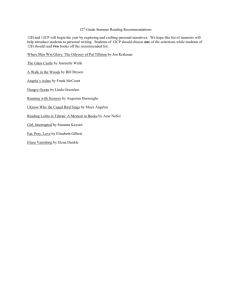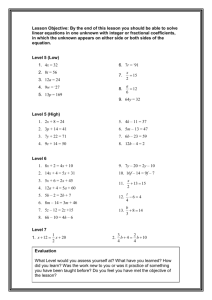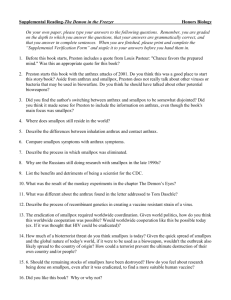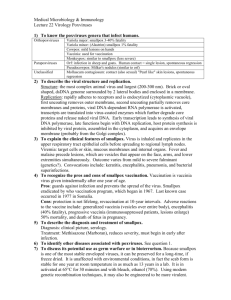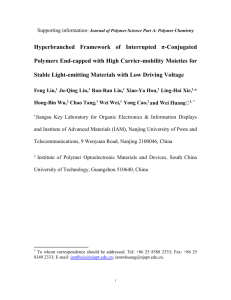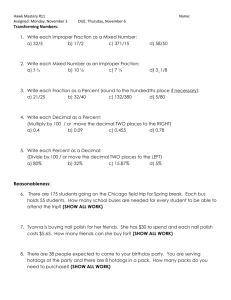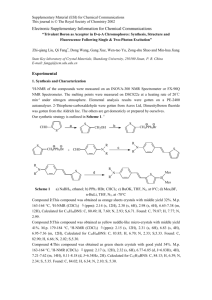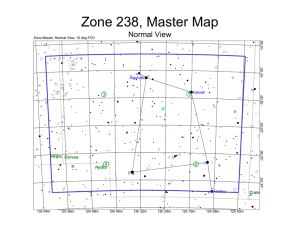BIOTERRORIST AGENTS
advertisement
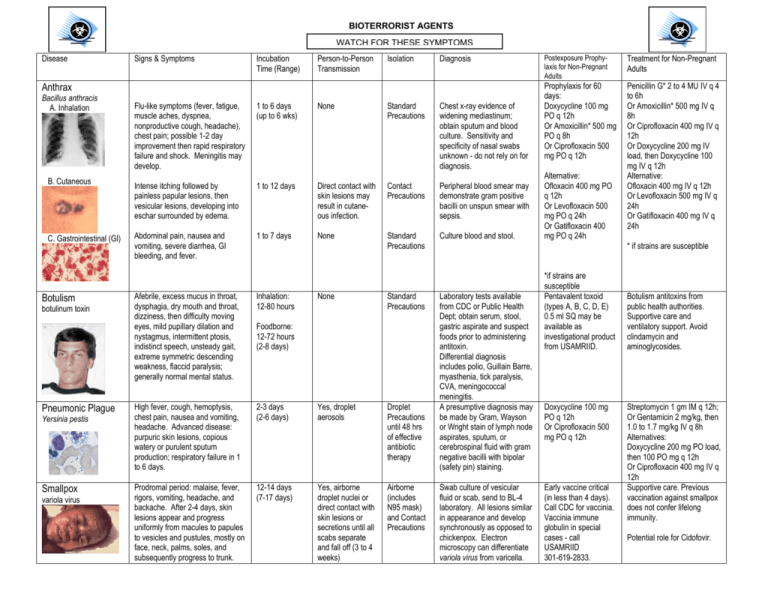
BIOTERRORIST AGENTS WATCH FOR THESE SYMPTOMS Disease Signs & Symptoms Incubation Time (Range) Person-to-Person Transmission Isolation Diagnosis Anthrax Bacillus anthracis A. Inhalation B. Cutaneous C. Gastrointestinal (GI) Flu-like symptoms (fever, fatigue, muscle aches, dyspnea, nonproductive cough, headache), chest pain; possible 1-2 day improvement then rapid respiratory failure and shock. Meningitis may develop. 1 to 6 days (up to 6 wks) None Standard Precautions Chest x-ray evidence of widening mediastinum; obtain sputum and blood culture. Sensitivity and specificity of nasal swabs unknown - do not rely on for diagnosis. Intense itching followed by painless papular lesions, then vesicular lesions, developing into eschar surrounded by edema. 1 to 12 days Direct contact with skin lesions may result in cutaneous infection. Contact Precautions Peripheral blood smear may demonstrate gram positive bacilli on unspun smear with sepsis. Abdominal pain, nausea and vomiting, severe diarrhea, GI bleeding, and fever. 1 to 7 days None Standard Precautions Culture blood and stool. Afebrile, excess mucus in throat, dysphagia, dry mouth and throat, dizziness, then difficulty moving eyes, mild pupillary dilation and nystagmus, intermittent ptosis, indistinct speech, unsteady gait, extreme symmetric descending weakness, flaccid paralysis; generally normal mental status. Inhalation: 12-80 hours Pneumonic Plague High fever, cough, hemoptysis, chest pain, nausea and vomiting, headache. Advanced disease: purpuric skin lesions, copious watery or purulent sputum production; respiratory failure in 1 to 6 days. Smallpox Prodromal period: malaise, fever, rigors, vomiting, headache, and backache. After 2-4 days, skin lesions appear and progress uniformly from macules to papules to vesicles and pustules, mostly on face, neck, palms, soles, and subsequently progress to trunk. Botulism botulinum toxin Yersinia pestis variola virus None Standard Precautions 2-3 days (2-6 days) Yes, droplet aerosols Droplet Precautions until 48 hrs of effective antibiotic therapy 12-14 days (7-17 days) Yes, airborne droplet nuclei or direct contact with skin lesions or secretions until all scabs separate and fall off (3 to 4 weeks) Airborne (includes N95 mask) and Contact Precautions Foodborne: 12-72 hours (2-8 days) Postexposure Prophylaxis for Non-Pregnant Adults Treatment for Non-Pregnant Adults Prophylaxis for 60 days: Doxycycline 100 mg PO q 12h Or Amoxicillin* 500 mg PO q 8h Or Ciprofloxacin 500 mg PO q 12h Penicillin G* 2 to 4 MU IV q 4 to 6h Or Amoxicillin* 500 mg IV q 8h Or Ciprofloxacin 400 mg IV q 12h Or Doxycycline 200 mg IV load, then Doxycycline 100 mg IV q 12h Alternative: Ofloxacin 400 mg IV q 12h Or Levofloxacin 500 mg IV q 24h Or Gatifloxacin 400 mg IV q 24h Alternative: Ofloxacin 400 mg PO q 12h Or Levofloxacin 500 mg PO q 24h Or Gatifloxacin 400 mg PO q 24h * if strains are susceptible Laboratory tests available from CDC or Public Health Dept; obtain serum, stool, gastric aspirate and suspect foods prior to administering antitoxin. Differential diagnosis includes polio, Guillain Barre, myasthenia, tick paralysis, CVA, meningococcal meningitis. A presumptive diagnosis may be made by Gram, Wayson or Wright stain of lymph node aspirates, sputum, or cerebrospinal fluid with gram negative bacilli with bipolar (safety pin) staining. Swab culture of vesicular fluid or scab, send to BL-4 laboratory. All lesions similar in appearance and develop synchronously as opposed to chickenpox. Electron microscopy can differentiate variola virus from varicella. *if strains are susceptible Pentavalent toxoid (types A, B, C, D, E) 0.5 ml SQ may be available as investigational product from USAMRIID. Doxycycline 100 mg PO q 12h Or Ciprofloxacin 500 mg PO q 12h Early vaccine critical (in less than 4 days). Call CDC for vaccinia. Vaccinia immune globulin in special cases - call USAMRIID 301-619-2833. Botulism antitoxins from public health authorities. Supportive care and ventilatory support. Avoid clindamycin and aminoglycosides. Streptomycin 1 gm IM q 12h; Or Gentamicin 2 mg/kg, then 1.0 to 1.7 mg/kg IV q 8h Alternatives: Doxycycline 200 mg PO load, then 100 PO mg q 12h Or Ciprofloxacin 400 mg IV q 12h Supportive care. Previous vaccination against smallpox does not confer lifelong immunity. Potential role for Cidofovir. Photo Credits: Anthrax A and C - JAMA 1999;281:1737-8 ; Anthrax B - CDC; Botulism - JAMA 2001;285:1062 Copyrighted 2001 American Medical Association; Plague - JAMA 2000;283:2283; Smallpox - CDC References: • Arnon SS, Schechter R, Inglesby TV, et al. for the Working Group on Civilian Biodefense. Botulinum toxin as a biological weapon: medical and public health management. JAMA 2001;285:1059-1070. • Centers for Disease Control and Prevention. Chemical/Biological Survival Cards for Civilians. 2000. • Chin J, ed. Control of Communicable Diseases Manual. 17th edition. Washington, DC: American Public Health Association. 2000. • Henderson DA, Inglesby TV, Bartlett JG, et al. for the Working Group on Civilian Biodefense. Smallpox as a biological weapon; medical and public health management. JAMA 1999;281:2127-2137. • Inglesby TV, Henderson DA, Bartlett JG, et al. for the Working Group on Civilian Biodefense. Anthrax as a biological weapon: medical and public health management. JAMA 1999;281:1735-1745. • Inglesby TV, Dennis DT, Henderson DA, et al. for the Working Group on Civilian Biodefense. Plague as a biological weapon: medical and public health management. JAMA 2000;283:2281-2290. • U.S. Army Medical Research Institute of Infectious Diseases. USAMRIID's Medical Management of Biological Casualties Handbook. 4th ed. Fort Detrick, Frederick, Maryland. 2001. NOTIFICATION PROCEDURES IN THE EVENT OF A BIOTERRORIST INCIDENT 1. 2. First call the Public Health Officer at your local health department; after hours contact local Health Director via 911. If criminal activity is suspected, call your local law enforcement and the FBI in your state. FOR MORE INFORMATION ON BIOTERRORISM: CDC - Centers for Disease Control and Prevention www.bt.cdc.gov/ DECONTAMINATION FOR ALL OF THESE AGENTS 1. 2. 3. 4. 5. Place clothing from suspected victims in airtight impervious (e.g., plastic) bags and save for law authorities (e.g., FBI, SBI). Use soap and water for washing victim. For environmental disinfection for all of the above, use bleach (standard 6.0% - 6.15% sodium hypochlorite ) in a 0.6% concentration (1 part bleach to 9 parts water). For botulism, plague and smallpox an alternative is to use an EPA-approved germicidal detergent. For smallpox, all bedding and clothing must be autoclaved or laundered in hot water and bleach. Healthcare worker should wear PPE (gowns, gloves and mask) during decontamination of anthrax, plague, and smallpox. APIC - Association for Professionals in Infection Control & Epidemiology www.apic.org/bioterror/ DETECTION OF OUTBREAKS Epidemiologic Strategies • A rapidly increasing disease incidence • An unusual increase in the number of people seeking care, especially with fever, respiratory, or gastrointestinal symptoms • An endemic disease rapidly emerging at an uncharacteristic time or in an unusual pattern USAMRIID's Medical Management of Biological Casualties Handbook • Lower attack rate among persons who had been indoors www.usamriid.army.mil/education/bluebook.html • Clusters of patients arriving from a single locale • Large numbers of rapidly fatal cases • Any patient presenting with a disease that is relatively uncommon and has bioterrorism potential Chart developed by: North Carolina Statewide Program for Infection Control and Epidemiology (SPICE) email: spice@unc.edu SPICE - North Carolina Statewide Program for Infection Control and Epidemiology www.unc.edu/depts/spice/ 919-966-3242 KK Hoffmann, DJ Weber, EP Clontz, WA Rutala Support provided by: The North Carolina Institute for Public Health and The North Carolina Center for Public Health Preparedness, in the School of Public Health at The University of North Carolina at Chapel Hill In view of the possibility of human error or changes in medical sciences, neither the authors, nor the publisher, nor any other party who has been involved in the preparation or publication of this work warrants that the information contained herein is in every respect accurate or complete. Readers are encouraged to confirm the information contained herein with other sources and check drug package insert for warnings and contraindications. Funding for chart provided by: Allegiance Healthcare, a Cardinal Health company Bayer Corporation Bristol Myers Squibb Clorox Becton, Dickinson and Company Ortho-McNeil Pharmaceutical Kendall © by the University of North Carolina at Chapel Hill. Not to be used for other than non-profit educational purposes without written permission of copyright owner.
